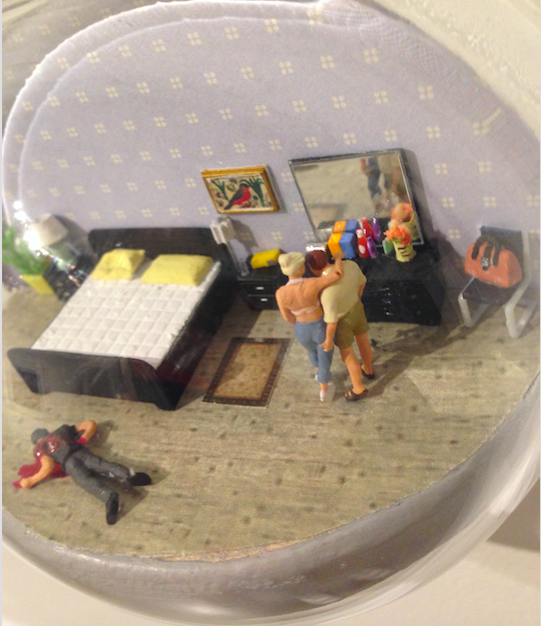Dioramas are typically three-dimensional models of landscapes or imagined spaces. Artists at the City of Palo Alto Art Center exhibition “Through That Which is Seen” used dioramas to transport us into their own microcosms — manipulating materials as basic as plastic and paint to create cities within an analog clock and compose scenes within a hole in the wall.
Won Ju Lim, for instance, uses mixed media installations to immerse the viewer in fantasy and nostalgia, while Joshua Smith uses paper, wood and paint to sculpt neglected urban landscapes. The range of mediums in this exhibition was impressive, spanning from photographs and cloth sculptures to sculpted glass. As I walked through the gallery on April 7th (the day before its closing), I was immediately drawn to Abigail Goldman’s haunting and humorous miniatures depicting various violent circumstances.
American artist Abigail Goldman works with miniatures to create what she coins “dieoramas,” sculptures of murder scenes. She stated in the Huffington Post that she is “not inspired by true cases” and only executes on what she can imagine on her own. Although her art does not draw directly from scenes she encountered as a crime reporter at the Las Vegas Sun or investigator for the Federal Public Defender of Nevada, her interest in crime clearly asserts itself continuously through her art, as evidenced by artwork titles in the exhibition such as “Dropped & Chopped” (2017).
Images of miniature shootings and dismembered body parts certainly shock viewers, but I was fascinated by Goldman’s ability to play with size and color to heighten viewers’ awareness of their misguided expectations. If Goldman were to have painted a close-up of the couple in “Lunch Date” eating a beheaded woman, the image would be violent, but the gruesomeness would domineer the playfulness and the initial covertness of her miniature sculpture. The colors and forms remind us of childhood toys — idle, idealistic and spurred into action by a human hand. We approach the miniatures as if they are embodiments of social conventions and thus are prepared to make quick associations that make the relations and scenes easy to understand.
In this way, Goldman draws us into the artwork by leveraging our sense of familiarity and highlighting the incongruity. We expect to project a story onto the little figures or at least contribute to the connections that bring them to life. Yet, upon leaning in, we realize the diorama can tell its own story. The violent image and glass bulbs that contain these reimagined worlds force us to be spectators and question our role as observers of scenes within our own world or at least scenes that resemble our world.
The size of the figures, barely 1 to 2 centimeters tall, suggests they are not intimidating, nor demanding attention. Thus, by design, individuals enter “Lunch Date” with a memory or feeling that is compelling enough to bring them closer — be it due to curiosity or a desire to re-encounter a piece of their childhood. Goldman makes use of the viewer’s perceptual baggage by displaying miniatures in violent action. The figurines are frozen in these acts — one such act being cannibalism — that society would never want to see or display. It is the artist’s betrayal of the viewer that encourages us to question: Are these images unsettling because they lie within our capabilities?
Society is chaotic and full of imperfections, yet when we create tools for storytelling — be it film or children’s toys — we highlight beauty and order. Goldman helps us recognize the complexity of our nature by displaying acts of savagery and using elements of the natural environment such as soil and greenery to ground these violent images in the reality of our surroundings. Goldman transforms an unsuspecting viewer into an uneasy investigator of our own psyche, forcing us to confront our darker thoughts and fascinations, such as our appetite for violence.
“Through That Which is Seen” powerfully invites visitors to not only imagine landscapes beyond our own but also to dissect our social, political and environmental issues scene by scene, calling us to attentively examine both the truth and the possibilities in who we are and what we see in ourselves.
Contact Chloe Barreau at chloeb88 ‘at’ stanford.edu.
